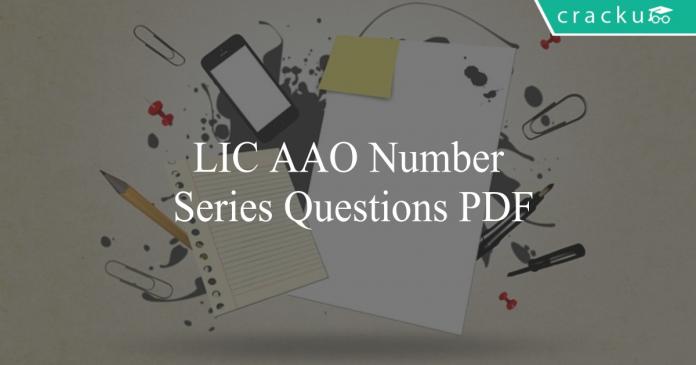LIC AAO Number Series Questions PDF
Download Important Number Series questions for LIC AAO exam. Top 20 Reasoning questions with answers based on previous year asked questions.
Download LIC AAO Number Series Questions PDF
10 LIC AAO Mock Tests – Just Rs. 117
Download LIC AAO Previous Papers PDF
Take a free mock test for LIC AAO
Question 1: Find the missing number in series:
2, 5, 9, ?, 20, 27
a) 14
b) 16
c) 18
d) 24
Question 2: How many 7’s are there in the following series which are preceded by 6, which is not preceded by 8 ?
8 7 6 7 8 6 7 5 6 7 9 7 6 1 6 7 7 6 8 8 6 9 7 6 8 7
a) Two
b) Nil
c) One
d) Three
Instructions
Study the following arrangement of letters/numbers/symbols carefully and answer the questions given below :
J & B L E H $ 3 C % 8 I F M 4 1 A R 6 V $\uparrow$ 9 D 5 K U 2 T ? Z
Question 3: How many such symbols are there in the above arrangement each of which is immediately preceded by a digit and also immediately followed by a consonant?
a) None
b) One
c) Two
d) Three
e) More than three
Download LIC AAO Previous Papers PDF
100 Free Computer Awareness Tests for LIC
Question 4: On the basis of the positions in the above arrangement if H is related to I, then F is related to
a) $\uparrow$
b) 9
c) D
d) 6
e) R
Question 5: If all the numbers are deleted from the above arrangement, which of the following would be the seventh from the left end?
a) C
b) $
c) H
d) %
e) I
100 Free GK Tests for Insurance Exams
Question 6: If all the alphabets are deleted from the above arrangement, which of the following will be the third from the right end?
a) 4
b) $\uparrow$
c) 1
d) 5
e) 9
Question 7: The position of how many digits will remain the same if the digits in the number 7029351648 are rearranged in the ascending order from the left to right?
a) None
b) One
c) Two
d) Three
e) More than three
Question 8: What should come in the place of question mark (?) in the following number series?
3 4 4 3 4 4 5 3 4 4 5 6 ? 4 4 5 6 7 3 4 4 5 6 7 8
a) 4
b) 3
c) 6
d) 5
e) None of these
Instructions
What will come in the place of question mark (?) in the following number series ?
Question 9: 13 14 22 31 95 120 ?
a) 336
b) 332
c) 325
d) 225
e) 425
Question 10: 9 ? 161 504 1233 2564
a) 23
b) 34
c) 32
d) 36
e) None of these
LIC AAO REASONING QUESTIONS PDF
Question 11: 11 ? 87 258 771 2310
a) 24
b) 30
c) 36
d) 45
e) 54
Question 12: 14 9 11 18.5 ? 99.5 300.5
a) 37.5
b) 39
c) 36
d) 38.5
e) None of these
Question 13: 36.2 37.6 39.4 41.6 ? 47.2 50.6
a) 44.2
b) 44.4
c) 44.6
d) 42.2
e) None of these
Instructions
Find the missing number (?) in the given series from the options provided.
Question 14: 2, 4, 7, 11, 16, ?
a) 22
b) 21
c) 20
d) 23
e) 24
Question 15: 9, 27, 45, 63, ?
a) 79
b) 80
c) 81
d) 82
e) 83
Question 16: 3, 8, 15, 24, 35, ?
a) 63
b) 49
c) 80
d) 48
e) 56
Question 17: -3, -1, 11, 39, 89, ?
a) 198
b) 189
c) 210
d) 174
e) 167
Question 18: 9, 12, 19, 34, 65, ?
a) 127
b) 128
c) 129
d) 130
e) 134
Instructions
Find the missing number (?) in the given series from the options provided.
Question 19: 3, 12, 25, 42, 63,?
a) 88
b) 77
c) 78
d) 83
e) 87
Question 20: 6, 24, 60, 120, 210, ?
a) 345
b) 336
c) 326
d) 316
e) 320
Download General Science Material PDF
Answers & Solutions:
1) Answer (A)
2) Answer (D)
There are 3 such 7 preceeded by which is not preceeded by 8.
8 7 6 7 8 6 7 5 6 7 9 7 6 1 6 7 7 6 8 8 6 9 7 6 8 7
Therefore, the correct option is option D.
3) Answer (A)
4) Answer (D)
5) Answer (B)
6) Answer (D)
7) Answer (C)
8) Answer (B)
9) Answer (A)
10) Answer (D)
11) Answer (C)
12) Answer (B)
13) Answer (A)
14) Answer (A)
$\Rightarrow$ $T_{2} – T _{1} = 4 – 2 = 2$
$\Rightarrow$ $T_{3} – T _{2} = 7 – 4 = 3$
$\Rightarrow$ $T_{4} – T _{3} = 11 – 7 = 4$
$\Rightarrow$ $T_{5} – T _{4} = 16 – 11 = 5$
Here we can see the pattern that difference between consecutive terms are in A.P. and it is increasing by 1. Therefore,
$\Rightarrow$ $T_{6} = 6 + T _{5} = 6+16 = 22$
Hence, option A is the correct answer.
15) Answer (C)
$\Rightarrow$ $T_{1} = 9 = 5^2 – 4^2$
$\Rightarrow$ $T_{2} = 27 = 6^2 – 3^2$
$\Rightarrow$ $T_{3} = 45 = 7^2 – 2^2$
$\Rightarrow$ $T_{4} = 63 = 8^2 – 1^2$
Hence, we can say that $\Rightarrow$ $T_{n} = (n+4)^2 – (5-n)^2$
$\Rightarrow$ $T_{5} = (5+4)^2 – (5-4)^2 = 81$
Hence, option C is the correct answer.
16) Answer (D)
$\Rightarrow$ $T_{1} = 3 = 2^2 – 1$
$\Rightarrow$ $T_{2} = 8 = 3^2 – 1$
$\Rightarrow$ $T_{3} = 15 = 4^2 – 1$
$\Rightarrow$ $T_{4} = 24 = 5^2 – 1$
$\Rightarrow$ $T_{5} = 35 = 6^2 – 1$
Hence, we can say that $\Rightarrow$ $T_{n} = (n+1)^2 – 1$
$\Rightarrow$ $T_{6} = (6+1)^2 – 1 = 48$
Hence, option D is the correct answer.
17) Answer (E)
$\Rightarrow$ $T_{1} = -3 = 1^3 – 2^2$
$\Rightarrow$ $T_{2} = -1 = 2^3 – 3^2$
$\Rightarrow$ $T_{3} = 11 = 3^3 – 4^2$
$\Rightarrow$ $T_{4} = 39 = 4^3 – 5^2$
$\Rightarrow$ $T_{5} = 89 = 5^3 – 6^2$
Hence, we can say that $\Rightarrow$ $T_{n} = n^3 – (n+1)^2$
$\Rightarrow$ $T_{6} = 6^3 – 7^2 = 167$
Hence, option E is the correct answer.
18) Answer (B)
$\Rightarrow$ $T_{1} = 9 = 2^2 + 5$
$\Rightarrow$ $T_{2} = 12 = 2^3 + 4$
$\Rightarrow$ $T_{3} = 19 = 2^4 + 3$
$\Rightarrow$ $T_{4} = 34 = 2^5 + 2$
$\Rightarrow$ $T_{5} = 65 = 2^6 + 1$
Hence, we can say that $\Rightarrow$ $T_{n} = 2^{n+1} + (6 -n)$
$\Rightarrow$ $T_{6} = 2^{6+1} + (6 – 6) = 128$
Hence, option B is the correct answer.
19) Answer (A)
$\Rightarrow$ $T_{1} = 3 = 3*1$
$\Rightarrow$ $T_{2} = 12 = 4*3$
$\Rightarrow$ $T_{3} = 25 = 5*5$
$\Rightarrow$ $T_{4} = 42 = 6*7$
$\Rightarrow$ $T_{5} = 63 = 7*9$
Hence, we can say that $\Rightarrow$ $T_{n} = (n+2)*(2n -1)$
$\Rightarrow$ $T_{6} = 8*11 = 88$
Hence, option A is the correct answer.
20) Answer (B)
We can see that
$\Rightarrow$ $T_{1} = 6 = 1*2*3$
$\Rightarrow$ $T_{2} = 24 = 2*3*4$
$\Rightarrow$ $T_{3} = 60 = 3*4*5$
$\Rightarrow$ $T_{4} = 120 = 4*5*6$
$\Rightarrow$ $T_{5} = 120 = 5*6*7$
Hence we can generalise that $T_{n} = (n)*(n+1)*(n+2)$
$\Rightarrow$ $T_{6} = 6*7*8 = 336$
Hence, option B is the correct answer.





